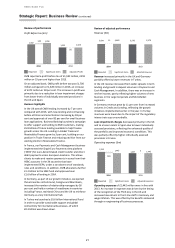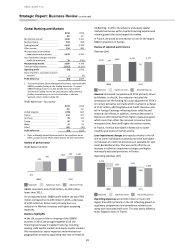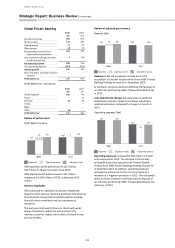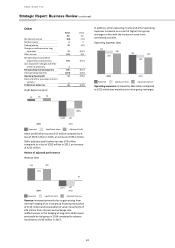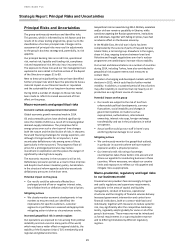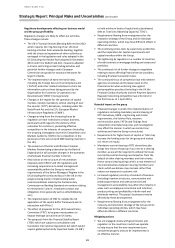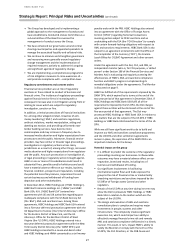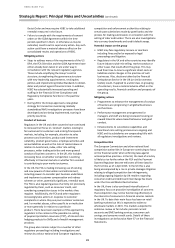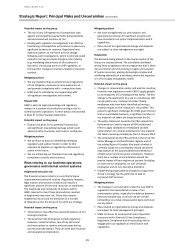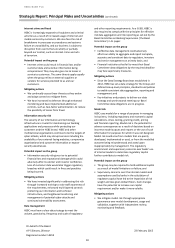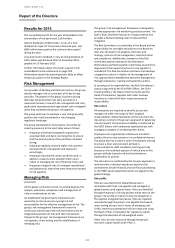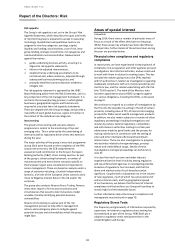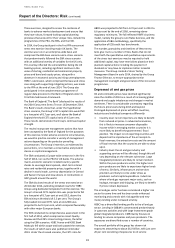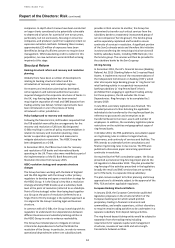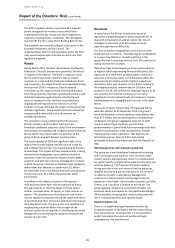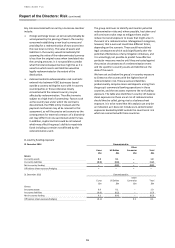HSBC 2014 Annual Report Download - page 28
Download and view the complete annual report
Please find page 28 of the 2014 HSBC annual report below. You can navigate through the pages in the report by either clicking on the pages listed below, or by using the keyword search tool below to find specific information within the annual report.
HSBC BANK PLC
Strategic Report: Principal Risks and Uncertainties (continued)
26
Regulatory developments affecting our business model
and the group profitability
Regulatory changes are likely to affect our activities.
These changes include:
• The UK’s Financial Services (Banking Reform) Act 2013
which requires the ring-fencing of our UK retail
banking activities from wholesale banking, together
with the structural separation of other activities as
envisaged in the legislation and rules adopted in the
US (including the Volcker Rule adopted in December
2013 under the Dodd-Frank Act), measures adopted
in France restricting certain trading activities and
potential further changes under European
Commission proposals for structural measures for
larger EU banks.
• The implementation of extra-territorial laws,
including the Foreign Account Tax Compliance Act
(‘FATCA’) and other related initiatives to share tax
information such as those being pursued by the
Organisation for Economic Co-operation and
Development (‘OECD’) more generally.
• Changes in the regime for the operation of capital
markets, notably mandatory central clearing of over
the counter (‘OTC’) derivatives, including under the
Dodd-Frank Act and the EU’s European Market
Infrastructure Regulation (‘EMIR’).
• Changes arising from the increasing focus by
regulators on how institutions conduct business,
particularly with regard to the delivery of fair
outcomes for customers, promoting effective
competition in the interests of consumers (including
the on-going investigation by the UK Competition and
Markets Authority (‘CMA’) into competition in the
personal current account and SME banking markets in
the UK).
• The outcome of the Fair and Effective Financial
Markets Review being undertaken by the Bank of
England which will consider changes in the operation
of wholesale financial markets in the UK.
• Restrictions on the structure of remuneration
imposed under CRD IV and UK regulations and
increasing requirements to detail management
accountability within the Group to meet the
requirements of the Senior Managers’ Regime in the
UK (including the continued focus in the UK on the
progress being made in implementing wider
recommendations made by the Parliamentary
Commission on Banking Standards on matters relating
to institutional ‘culture’, employee conduct and
obligations more generally such as whistleblowing
etc.).
• The implementation of CRD IV, notably the UK
application of the capital buffer framework and its
interaction with Pillar 2.
• The effect of proposals for the UK Financial Policy
Committee (‘FPC’) to be given more powers to
impose leverage constraints on UK banks.
• The proposals from the Financial Stability Board
(‘FSB’) which are subject to consultation and
translation into national regulations but which would
require global systemically important banks (‘G-SIB’)
to hold minimum levels of capital and subordinated
debt as Total Loss Absorbing Capacity (‘TLAC’).
• Requirements flowing from arrangements for the
resolution strategy of the Group and its individual
operating entities, which may have different effects in
different countries.
• The continuing stress-tests by supervisory authorities
and the implication for capital requirements and
capital transfers within the Group.
• The tightening by regulators in a number of countries
of credit controls on mortgage lending and unsecured
portfolios.
• The continued risk of further changes to regulation
relating to taxes affecting financial service providers,
including financial transaction taxes.
• The continued focus of competition law enforcement
agencies at national and European level on the
financial sector when enforcing laws against
anticompetitive practices (including in the UK the
Financial Conduct Authority and the Payment Systems
Regulator becoming competition law enforcers for
the first time as of 1 April 2015).
Potential impact on the group
• Proposed changes in and/or the implementation of
regulations including mandatory central clearing of
OTC derivatives, EMIR, ring-fencing and similar
requirements, the Volcker Rule, recovery
and resolution plans, FATCA and findings from
competition orientated enquiries and investigations
may affect the manner in which we conduct our
activities and how the Group is structured.
• Requirements for higher levels of capital or TLAC may
increase the funding costs for the group and reduce
our return on equity.
• Mandatory central clearing of OTC derivatives also
brings new risks to the group in our role as a clearing
member, as we will be required to underwrite losses
incurred by central clearing counterparties from the
default of other clearing members and their clients.
Hence central clearing brings with it a new element of
interconnectedness between clearing members and
clients which we believe may increase rather than
reduce our exposure to systemic risk.
• Increased regulatory scrutiny of conduct of business
(including incentive structures, remuneration and
product governance and sales processes) and
management accountability may affect the industry in
areas such as employee recruitment and retention,
product pricing and profitability in both retail and
wholesale markets. The group’s businesses may be
affected by these developments.
• Requirements flowing from arrangements for the
recovery and resolution strategy of the Group and its
individual operating entities, which may have
different effects in different countries.
Mitigating actions
• We are engaged closely with governments and
regulators in the countries in which we operate
to help ensure that the new requirements are
considered properly and can be implemented in
an effective manner.







